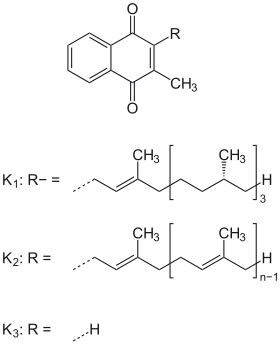
Back Vitamien K Afrikaans فيتامين ك Arabic Vitamina K AST K vitamini Azerbaijani ویتامین کا AZB Vitamin K BAN Bitamina K BCL Витамин K Bulgarian ভিটামিন কে Bengali/Bangla Vitamin K BS
| Vitamin K | |
|---|---|
| Drug class | |
 Vitamin K structures. | |
| Class identifiers | |
| Use | Vitamin K deficiency, Warfarin overdose |
| ATC code | B02BA |
| Biological target | Gamma-glutamyl carboxylase |
| Clinical data | |
| Drugs.com | Medical Encyclopedia |
| External links | |
| MeSH | D014812 |
| Legal status | |
| In Wikidata | |
Vitamin K is a family of structurally similar, fat-soluble vitamers found in foods and marketed as dietary supplements.[1] The human body requires vitamin K for post-synthesis modification of certain proteins that are required for blood coagulation ("K" from Danish koagulation, for "coagulation") or for controlling binding of calcium in bones and other tissues.[2] The complete synthesis involves final modification of these so-called "Gla proteins" by the enzyme gamma-glutamyl carboxylase that uses vitamin K as a cofactor.
Vitamin K is used in the liver as the intermediate VKH2 to deprotonate a glutamate residue and then is reprocessed into vitamin K through a vitamin K oxide intermediate.[3] The presence of uncarboxylated proteins indicates a vitamin K deficiency. Carboxylation allows them to bind (chelate) calcium ions, which they cannot do otherwise.[4] Without vitamin K, blood coagulation is seriously impaired, and uncontrolled bleeding occurs. Research suggests that deficiency of vitamin K may also weaken bones, potentially contributing to osteoporosis, and may promote calcification of arteries and other soft tissues.[2][4][5]
Chemically, the vitamin K family comprises 2-methyl-1,4-naphthoquinone (3-) derivatives. Vitamin K includes two natural vitamers: vitamin K1 (phylloquinone) and vitamin K2 (menaquinone).[4] Vitamin K2, in turn, consists of a number of related chemical subtypes, with differing lengths of carbon side chains made of isoprenoid groups of atoms. The two most studied are menaquinone-4 (MK-4) and menaquinone-7 (MK-7).
Vitamin K1 is made by plants, and is found in highest amounts in green leafy vegetables, being directly involved in photosynthesis. It is active as a vitamin in animals and performs the classic functions of vitamin K, including its activity in the production of blood-clotting proteins. Animals may also convert it to vitamin K2, variant MK-4. Bacteria in the gut flora can also convert K1 into K2. All forms of K2 other than MK-4 can only be produced by bacteria, which use these during anaerobic respiration. Vitamin K3 (menadione), a synthetic form of vitamin K, was used to treat vitamin K deficiency, but because it interferes with the function of glutathione, it is no longer used in this manner in human nutrition.[2]
- ^ "Fact Sheet for Health Professionals – Vitamin K". US National Institutes of Health, Office of Dietary Supplements. June 2020. Retrieved 26 August 2020.
- ^ a b c "Vitamin K". Corvallis, OR: Micronutrient Information Center, Linus Pauling Institute, Oregon State University. July 2014. Retrieved 20 March 2017.
- ^ Shearer MJ, Okano T (August 2018). "Key Pathways and Regulators of Vitamin K Function and Intermediary Metabolism". Annual Review of Nutrition. 38 (1): 127–151. doi:10.1146/annurev-nutr-082117-051741. ISSN 0199-9885. PMID 29856932. S2CID 207573643.
- ^ a b c BP Marriott, DF Birt, VA Stallings, AA Yates, eds. (2020). "Vitamin K". Present Knowledge in Nutrition, Eleventh Edition. London, United Kingdom: Academic Press (Elsevier). pp. 137–154. doi:10.1002/9781119946045.ch15. ISBN 978-0-323-66162-1.
- ^ Cite error: The named reference
DRItextwas invoked but never defined (see the help page).